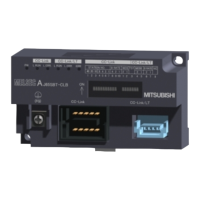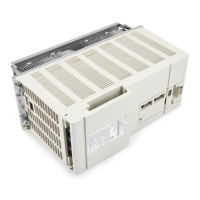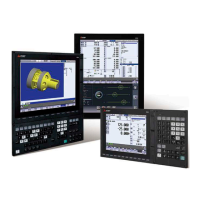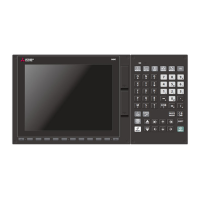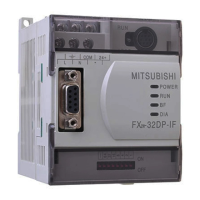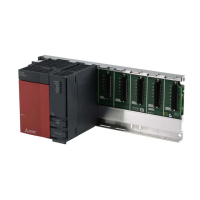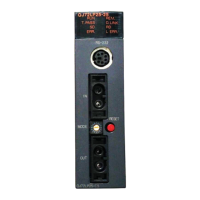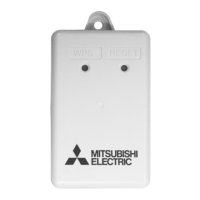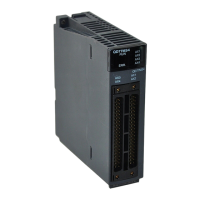
Do you have a question about the Mitsubishi MELSEC-Q QD77MS and is the answer not in the manual?
| Category | Control Unit |
|---|---|
| Power Supply | 24 VDC |
| Positioning Command Resolution | 1 pulse |
| Current Consumption | 0.5 A |
| Control Method | Position control, speed control, torque control |
| Positioning Data | 600 points per axis |
Specifies conditions for using the programmable controller, focusing on safety and fail-safe functions.
Outlines Mitsubishi's liability limitations for unintended applications or misuse of the product.
Lists manual names and descriptions for Simple Motion Modules like MELSEC-Q QD77MS and QD77MS/LD77MH.
Lists manual names and descriptions for CPU modules like QCPU and QnUCPU.
Lists manual names and descriptions for programming tools like GX Works2.
Lists manual names and descriptions for various SSCNET interface servo amplifiers.
Provides an overview of the QD77MS specifications and functions, and outlines procedures for installation and wiring.
Explains positioning control concepts, QD77MS features, purpose, mechanism, functions, and system design.
Details the system operation flow, including installation, wiring, preparation, operation, and maintenance steps.
Provides an overview of the system configuration involving QD77MS, PLC CPU, and peripheral devices.
Lists the necessary devices for configuring the QD77MS positioning system.
Details the compatible CPU modules and base units for system configuration.
Explains methods to check the function version and serial number of the QD77MS.
Details the performance specifications of QD77MS models including control axes, operation cycle, interpolation functions, and speed command ranges.
Categorizes and explains the main functions of QD77MS, including OPR control, major positioning control, high-level positioning control, manual control, expansion control, and common functions.
Lists and details the input/output signals used for data exchange between QD77MS and the PLC CPU.
Explains electrical specifications, signal layouts, and internal circuits for external device connections.
Provides guidance on configuring power supply circuits and main circuits for forced stop upon alarm detection.
Explains procedures for installation, wiring, and maintenance, including precautions to prevent malfunctions and injuries.
Details the precautions for installing the QD77MS, covering handling, mounting, and screw tightening.
Provides precautions for wiring, including terminal layout, connector connections, and cable routing to prevent interference.
Lists items to confirm after installation and wiring, using GX Works2 positioning test function for verification.
Covers precautions for servicing the QD77MS, including daily inspections and part replacement.
Explains the parameters and data used for positioning control, including setting data, monitor data, and control data.
Details the setting items for positioning parameters, OPR parameters, expansion parameters, and servo parameters.
Explains the configuration of positioning data stored in the QD77MS buffer memory.
Explains the organization of block start data stored in the QD77MS buffer memory for high-level positioning control.
Explains the condition data setting items such as Condition target, Condition operator, Address, Parameter 1, and Parameter 2, which are used for conditional judgments.
Explains the monitor data area storing data related to the operating state of the positioning system.
Explains the setting items of control data used for controlling the positioning system.
Provides common precautions for writing data from PLC CPU to QD77MS buffer memory, including data handling and speed change restrictions.
Lists the devices used in sequence programs with QD77MS4, including I/O numbers and applications.
Explains the general configuration of the positioning control operation program and program details.
Provides example programs for positioning operations using QD77MS4, illustrating various controls.
Details specific programs like initialization, start details, start, interrupt, restart, and stop programs.
Explains the configuration and roles of the four memories within the QD77MS.
Details the data transmission patterns between QD77MS memories, PLC CPU, and servo amplifiers.
Explains the concept of OPR control, including its purpose and the two defined types: Machine OPR and Fast OPR.
Details the operation of Machine OPR, including establishing the OP position and methods for its establishment.
Explains the outline and operation timing of Fast OPR, which executes positioning to the OP position without using a near-point dog or zero signal.
Covers the conditions for selecting OPR settings, emphasizing the importance of the servomotor's home position return and zero point signal.
Introduces major positioning controls like position control, speed control, and switching controls, and how they use positioning data.
Explains how to set positioning data for various controls, including linear, circular, and speed controls.
Explains high-level positioning control, which uses block start data and condition data for applied control.
Details the step-by-step procedure for executing high-level positioning control, including preparation, setting, programming, and monitoring.
Covers setting block start data items like Shape, Start data No., Special start instruction, and Parameter, which are essential for high-level positioning control.
Explains setting condition data items such as Condition target, Condition operator, Address, Parameter 1, and Parameter 2, which are used for conditional judgments.
Describes how to start and control multiple axes simultaneously by outputting commands at the same timing.
Provides example programs for high-level positioning control, explaining procedures and timing charts.
Introduces manual control methods, including JOG operation, inching operation, and manual pulse generator operation.
Explains the outline, execution procedure, required parameters, start programs, and examples of JOG operation.
Details the outline, execution procedure, required parameters, programs for enabling/disabling, and examples of inching operation.
Covers the outline, execution procedure, required parameters, and programs for manual pulse generator operation.
Explains the details and usage of speed-torque control, covering its outline, required parameters, data settings, and operation.
Introduces sub functions that supplement main functions, including those for OPR, control compensation, and limiting.
Explains OPR retry and OP shift functions, which are specifically for machine OPR.
Details functions for compensating control, such as backlash compensation, electronic gear, and near pass functions.
Covers functions for limiting control, including speed, torque, software stroke, hardware stroke, and forced stop.
Explains functions for changing control details like speed, override, acceleration/deceleration time, torque, and target position.
Describes how to construct an absolute position system using QD77MS and SSCNET/H, including precautions.
Explains various other functions like Step, Skip, M code output, Teaching, Command in-position, Acceleration/deceleration processing, Pre-reading start, Deceleration start flag, Stop command processing, Speed control 10x multiplier, and Operation setting for incompletion of OPR.
Details the procedure for servo ON and servo OFF operations.
Introduces common functions executed according to the user's requirements, such as parameter initialization and execution data backup.
Explains the function to return parameters to factory-set initial values.
Details the function to back up execution data to flash ROM/internal memory.
Covers selecting external input signals for QD77MS, servo amplifier, or PLC CPU.
Explains how to switch I/O signal logic according to connected equipment.
Describes the function to monitor starting history, error history, and warning history.
Explains how to execute positioning control without connecting servo amplifiers, useful for debugging or simulation.
Covers the function that executes operation as a virtual servo amplifier axis.
Explains the function to latch data at the input timing of the mark detection signal.
Details the function to store and monitor selected data for each axis.
Explains how the QD77MS collects errors in the PLC CPU and stores them for history checking.
Describes the function to temporarily connect/disconnect SSCNET communication.
Explains how to set the factory-set initial value of QD75MH.
Lists the dedicated instructions available for facilitating programming of QD77MS functions.
Explains interlocks related to the simultaneous execution of positioning start and teaching instructions.
Details the dedicated instructions used to start positioning of a designated axis.
Explains the dedicated instructions used to teach the designated axis.
Describes the dedicated instruction used to write parameters, positioning data, and block start data to flash ROM.
Explains the dedicated instruction used to initialize setting data to factory-set values.
Guides users on how to check errors and their details using the "Module's Detailed Information" and "Error History" screens in GX Works2.
Explains how to check errors in QD77MS without software package by using a display unit.
Provides troubleshooting steps based on LED indicators for power supply, module connection, and system errors.
Lists various errors and warnings detected by QD77MS, including their causes and corrective actions.
Details QD77MS detection errors and servo amplifier detection errors, including error codes, names, and operation status.
Lists system warnings, axis warnings, and servo amplifier warnings detected by QD77MS.

